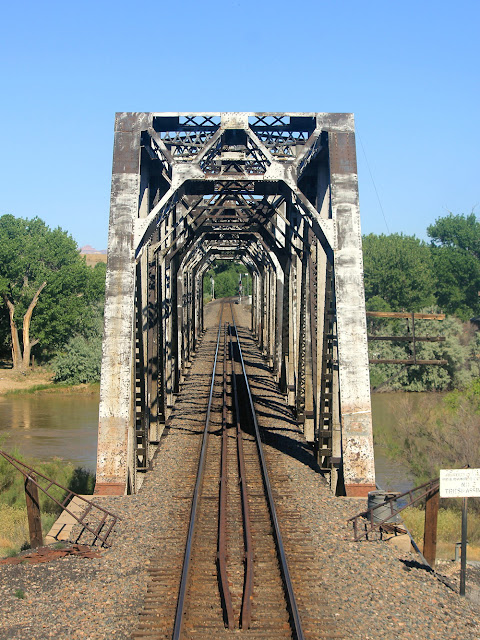The section of former Rio Grande trackage between Provo, Utah and Grand Junction Colorado is probably the most scenic on the entire Amtrak system. I had the privilege to survey this route back in 2012 and now it was time for a second bite at the apple, this time armed with a better knowledge of my camera's white balance issues.
One advantage to a late running Amtrak train is that it allows one to get coverage of parts of the line that are normally shrouded in darkness. When I had previously covered this line in 2006 I had woken up just a few minutes prior to Train 6's arrival in Helper, Utah somewhere in the vicinity of 6:30am. Two years later with the train running around 90 minutes late I got a nice little bonus photo session before I had to go back for breakfast.
You can see all the photos, including the newly covered segment west of Helper right here.
So just because the line was new to me doesn't mean that I was going to be guarenteed a lot of trains. Most of what I was offered was scenery and signals. Here we have the vintage DRG&W milepost 654 automatics with a Clear indication on Track #1 and a pair of stick type dragging equipment detectors.
A few miles to the east were the twin Kyune tunnels and a pair of repeater signals for KYUNE interlocking located on the other side.
The sunlight is hitting the milepost 637 automatic just right to show off the lower Lunar White lamp for the Approach Restricting indication that informs trains they are lined to enter the Restricted speed siding at Kyune.
More DRG&W styling is evident at the eastern portal of the Nolan tunnels.
The terrain gets a bit more...rugged...approaching Helper.
Encountering a train of empty coal hoppers west of Helper with UP C44/60AC #7021 and AC4400 #6850 pushing on the rear.
At the head end is AC4400 #6739 with an unidentified Southern pacific painted C40-8W.
In the Helper Yard were also a pair of UP SD40N yard locomotives #'s 1691 and 1637.
Here we see brand new UP SD70AH #8829 along with some of the dwarf signals bracketing the station platform which allows trains to avoid the delay in block rule.
In 2012 new signals had been dropped all along the former DRG&W main line and in 2014 some were still turned with the classic signals still in service such as these at Milepost 588.
Our pair of P42DC's add a bit of solar reflecting particulate matter to the air as they hit a stretch of unrestricted track at MP 563.

Amtrak station at Green River, UT.
Crossing the Green River on a multi-truss bridge.
Nothing quite says "the west" like Train 5/6.
East end of the Thompson siding. Note the broom for sweeping away snow or sand in the switch points.
UP AC4400 #6245 with an unidentified SP C44-8W waiting in the Sagers siding.
Pushing on the rear of the same loaded coal train are AC4400's 5692 and 5604.
Stored coal hoppers in the Agate siding.
Cool pyramid thing at MP 494.
Sheer rock cliffs make slide fences a necessity.
Sheer cliffs soon flank both sides of the Colorado River.
Center tapped pole line fed DC track circuit sitting amidst stunning scenery.
Long eastbound signal facing a rust red cliff.
Running along side the Colorado River.
This is probably the single most photogenic spot on the entire Amtrak network. The banded rocks formation just west of Shale with a Hotbox/Dragging Equipment detector in the foreground.
The scenery just doesn't stop.
It's like a rolling John Ford movie.
BNSF C44-10W #7338 all alone in front of a mixed freight on the Ruby siding.
BNSF C44-10W #7726, C44-9W #5085 and C44-9W #4661 were providing a bit of help on the rear.
Like one of those temples carved out of rock in the Arabian desert the tunnel at MP 471.9.
Not sure what's up with all the BNSF power. C44-9W #4372 was performing some local switching duty in the Frutia area.
At Grand Junction the old searchlight signals were gone, replaced by new LED types. Also removed were the repeater signals that gave stopping trains a faster departure.
Pair of BNSF ES44C4's, including #8084, at Grand Junction.
Our lead engine, Amtrak P42DC #22 at Grand Junction.
Well that's it for this week, next time I'll go back and re-do the part I missed crossing Nevada, but then its on to Denver.



































No comments:
Post a Comment